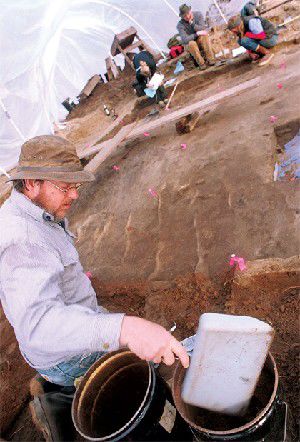Remarkable discovery
Published 4:00 pm Tuesday, January 25, 2005

- <I>DAMIAN MULINIX photo</I><BR>George Bishop scoops up small amounts of dirt being excavated from a site at Station Camp where archeologists believe they have uncovered the remains of a Chinook plank house from the early 19th century. The "veins" in the dirt are what they believe to be the roof planks of the structure. .
Chinook plank house may delay or halt highway work at National Park siteSTATION CAMP – A highly significant new find by archaeologists working at Station Camp at McGowan could delay or, possibly, halt work on a planned Highway 101 realignment project and construction of a new national park at the site where the Lewis and Clark Expedition reached the end of their cross-country journey.
National Park Service archaeologists working at the site this week made their most exciting discovery since the dig began several months ago, a find characterized by the project leader as a 10 on a scale of one to 10 in importance.
After breaking up and removing a concrete slab that was the floor of a dairy at McGowan into the 1930s, the carbonized remains of what is thought to be a Chinook Indian plank house were revealed.
After a meeting Tuesday with all the entities involved in the project, including members of the Chinook Tribe, Jilayne Jordon, Washington Department of Transportation Southwest Region public information officer, said DOT is “looking at the possibility that construction will be delayed so archaeologists can assess data found and perhaps extend the work window beyond the Friday deadline. It’s all up in the air right now.” Besides DOT and National Park Service, the state’s historical society also is involved in the project.
The dig was scheduled to end Friday and construction on the realignment of Highway 101 to make room for a new national park to commemorate the site where the Lewis and Clark Expedition first sighted the Pacific Ocean was to begin Monday.
Because of environmental issues, including a “fish migration window,” no construction can be done between March 1 and June 15. “It’s looking very likely the project will be delayed,” Jordan said. “How long? We don’t know. We’re addressing archaeological concerns and the team needs more time.”
Jordan said DOT options are to cancel the project entirely or to simply realign and modify the highway curve at the site because of safety issues. Thousands of people interested in the story of the site are expected to converge on the area between now and November.
Brian Harrison, of Columbia Diachronic Services in Astoria, said the find was “very exciting.” He speculated that the plank house remains were burned “because the tradition was to burn houses during epidemics.” Malaria was a big cause of death among native tribes along the Columbia River after the arrival of foreign ships, Harrison said. “Malaria killed at least 80 percent of the population along the lower river between 1780 and 1830,” he said.
Over the past couple of months, as the archaeological dig has progressed, a number of beads, ceramics, bottles and other artifacts, including at least one arrowhead,have been found at the site.
Now, about a half-dozen “highly trained professional” archaeologists from Oregon and Washington have been hired to assist in the excavations at McGowan, behind St. Mary’s Catholic Church, according to Harrison.
The significance of the site was greatly increased by being covered by concrete for so long, avoiding damage from plowing, cattle or early road construction. “It is very close to the surface,” Harrison said. “It would have been easy to damage.”
The archaeologists are conducting a “very meticulous excavation,” Fort Vancouver archaeologist and project leader Bob Cromwell said. “It’s very fragile. It’s a very significant site. We’re trying to understand what we’re seeing. The next step is to see what’s underneath.”
Claire Dean, an archaeological and ethnographic conservator with Dean and Associates Conservation Services in Portland, was at the site Tuesday to assess the find.
“I’m trying to help them get the remains out of the ground and help Bob (Cromwell) deal with them. This is remarkable,” she said. “It’s quite astounding to have any substance to the planks at all.”
Dean said besides one small area of burned wood about 5 millimeters thick, most of the planks had degraded to stains, and tiny plant roots have grown through them, making them very difficult to lift to investigate what, if anything, is underneath.
The discovery of any human remains would almost certainly necessitate a top-to-bottom reconsideration of what to do at the site. In late December, Washington state ended all work at a planned bridge over Hood Canal near Port Angeles after workers unearthed centuries-old Indian graves.









